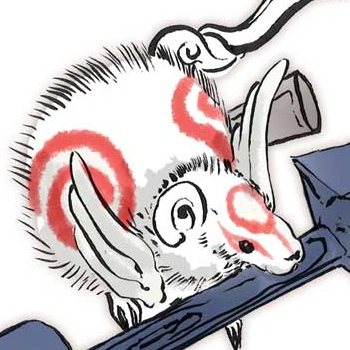So, say I get a set of chromosomes from my Mum which contains the X chromosome and the same from my Dad, but with the Y chromosome. I now have two sets of the same 22 chromosomes, plus an X and a Y.
For chromosome number one for example, is everything from my Dad’s side activated? My Mum’s? Or is is a random selection of genes within each chromosome?
And does the X chromosome do anything for me, or is it turned off, and only used if I pass it on to the next generation?
Follow up question: I believe that women actually recombine their X chromosomes when passing these on, but men can’t recombine X and Y. So everything on your Dad’s side stays the same. Does this have any impact? For example are you more likely to inherit genetic defects from your Dad’s side?
Everyone is talking about dominant and recessive genes, so I just want to clarify a couple things.
The way your body directly uses genes is as a blueprint to construct proteins. Your cells are always producing proteins from the genes in all your chromosomes. It has complex ways of regulating how much of each it produces, but your body doesn’t care what chromosome it’s coming from. Once an embryo is fertilized, there’s really no distinction between “mom” chromosomes or “dad” chromosomes, as far as the embryo and its protein machinery are concerned.
“Dominant” and “recessive” characterization is about how those proteins affect your body at the macro scale, not whether your body actually uses the gene and produces its proteins – it always does that. For example, brown hair is a dominant trait, and blonde is recessive. But this is because producing any amount of brown pigment will make your hair brown, regardless of what other pigments you’re making, simply because it’s darker. Literally the same as combining blonde and brown paint. It has nothing to do with whether the genes are actually being expressed – the brown hair gene doesn’t stop the blonde hair gene from making its pigments.
Thank you for clarifying those misconceptions about what recessive and dominant are getting at. A gene isn’t really dominant or recessive. A phenotype (some trait in the organism like blue eyes or a certain disease) can be dominant or recessive though and results from changes in a gene. The same gene could have many different possible mutations, some with dominant effects, some with recessive effects, or some with no effects, depending on the change in the gene and the phenotype.
To go further on that, many recessive diseases are because just one functional copy of many genes are fine from your body’s perspective. Many recessive diseases are due to loss of function of a gene or its protein product, a gene that for a variety of potential reasons no longer leads to a functional protein. Often your body can get by with just one working gene making protein, though both gene copies are generally always being transcribed and trying to be turned into functional protein.
One big exception to this is the x chromosome. Males only have one x and have a y instead of a second x. The y is very tiny and has very few genes compared to the x, quite different from other chromosome pairs which generally just have copies of all the same genes on each other. Early in embryo development for xx individuals, one of the x chromosomes is generally inactivated and not expressed very much, otherwise xx individuals would have double the gene products of all those different genes compared to males, which the body is not expecting for x genes like it does for all the other genes that have a second copy.
https://en.m.wikipedia.org/wiki/X-inactivation
If you go even further you also get into the idea of penetrance. A gene codes for a protein, but that protein doesn’t exist in isolation, it interacts with lots of other proteins coded by other genes in the body, plus the environment. So for some genetic changes it might be a 100% chance at leading to a certain phenotype (like a disease or a specific trait), or it could be less, like only 70% or 30% chance or something of someone with that change getting that trait, even if it’s still “dominant” (meaning only one gene copy with that change is needed to express the trait).
Best explanation so far. Nice work.
A couple of side points. OP’s X chromosome is definitely expressed. It has many genes that are essential to both men and women. It’s genes are not exclusively relating to sex differences. In fact, far from it.
Sex determination in humans is due (mostly) to a few genes on the Y chromosome. These both determine which sex organs will develop and also are critical for male fertility.
One of the major consequences of having a Y chromosome that doesn’t recombine with it’s partner X chromosome is that the Y chromosome has a tendency to lose genes and shrink over evolutionary times. This is prevented on chrX because it can recombine in females. It happens on chrY because there is little mechanistically to prevent it, and mutations resulting in loss are more common than those resulting in gain.
Oh yes absolutely op’s x chromosome is expressed. I just meant unlike all the other chromosomes where in general both gene copies on both chromosomes are expressed, in xx individuals usually one of the x chromomes is inactivated and only one of them is being expressed at a time. The x chromosome has many essential genes. This is why we have x linked genetic diseases as well. Often xx individuals are just carriers or more mildly affected since they have two x chromosomes, and xy individuals are more severely affected since they have no backup copies of that gene.
Also another misconception: There aren’t like a small number of genes and it’s not like each gene has a specific function. There are soooooo many genes and they all interact in unique and interesting ways. We’ve been trying to figure out what genes do what and how they interact for decades and have had only limited success.
Think of it like a lot of source code, but the source code is millions of years old and written by junior devs on their first week whilst high. There is a lot of stuff in there that does nothing, or seems to do a lot of things only to be completely voided by some other piece of code. Or it actually does something, but on the macro scale it’s pretty useless and doesn’t matter at all. All the code is spaghetti code, it all interacts and somehow a human being is formed by the result. To put this into context: mice have about 80% of the same sourcecode as us.
Oh that’s actually really neat, I had no idea! But it makes a lot of sense
Some genes are dominant and some are recessive. Dominant genes override recessive genes regardless of which parent it’s inherited from. Some genes that simply aren’t compatible with each other are altered during fertilization. These altered genes are called mutations. Some are beneficial, some are harmful, but most are benign. Some genes only come from the Mother, which would be the genes for the mitochondria. While some will only come from the father, which would be the genes for the nucleus.
As for X and Y chromosomes. The X chromosome contains a lot of info you need in order to live while the Y chromosome just codes for what makes a being male. If you have a defective gene in your X chromosome and are male, chances are that it’s going to present itself. If you’re female, it depends on if that gene is dominant. One notable case is the genes for the cones in your eyes. They reside in the X chromosome and sometimes one of those genes has mutated. If you only have the mutated version you may be unable to see some colors. As givesomefucks@lemmy.world pointed out, this has advantages and disadvantages.
Disclaimer: I’m going by what I remember from high school biology. If I made an error, then please correct me.
EDIT: Corrected my wording in regards to colorblindness.
They reside in the X chromosome and sometimes one is defective or missing. That’s why color blindness is more common in males.
Yeah. That’s a little out of date.
Colorblindness isn’t worse vision, just different.
You got more rods for the missing cones, it’s not just blank space.
That helps lowlight vision, and the colorblind are also better at differentiating shades of brown.
Like, my dad was colorblind, and he could spot a deer in the woods from like a mile away. To him it was completely obvious and he never got why other people couldn’t see the deer.
I didn’t mean to imply it was bad. I’ll reword my comment.
They reside in the X chromosome and sometimes one of those genes has mutated. If you only have the mutated version you may be unable to see some colors.
Also, with 2 x chromosomes it’s possible to get an extra set of cone cells and see more colors.
Ahh thanks, this is all coming back to me now! Despite being a pretty nerdy student, my biology teachers at school didn’t instil much enthusiasm in me for the subject. But the more I learn about it now, the more fascinating I find it.
Do you have any more detail/links about incompatible genes causing mutations?
It uses both. I’ve got a gene that is defective in both chromosomes. It’s defective in different places in both chromosomes. Because the encoding for an entire complete protein is there (just in two different chromosomes), it still kinda works. Not as good as if I didn’t have two defective alleles (copies of the gene), but still better than nothing.
Some genes are lethal let’s call them :
“T” bad version and
“t” for the version that lets you live.if one of those genes is on the xx // xy chromosomes then if you are XX female you will get one combination in this set of combinations : Tt, tT, TT, tt
if you get TT, you are dead.
if you get tt, you live,
if you get Tt or tT you have 3 possible outcomes :
if T is dominant you are dead,
if t is dominant you live,
if T and t are co_dominant you might be sick.if you are XY male, you have either a “T” (dead) or a “t” (alive).
I didn’t realize I have the same question as OP, and I don’t think you answered it. The question is: how do the gene selections happen? What process decides?
Not every combination is being tried in the egg during fertilization, right? You describe the outcome, but not how the gene combination selection process happens, and what decides which genes are used.
You might absolutely be right about the meaning of O.P.s’ (confused) question. But still i hope at least i answered o.k. from this part :
And does the X chromosome do anything for me, or is it turned off, and only used if I pass it on to the next generation ?
P.S. : You asked :
Not every combination is being tried in the egg during fertilization, right ?
Gene selection is made before the synthesis of the gametes : for instance a male having XY will produce sperms, each one with either an X or with a Y.
You get half of your chromosomes from each of your parents, so their bodies are in charge of setting which half their child will use.
Afterwards which trait will be present goes into dominant and recessive genes.
(of course this is more complicated and someone might do a better job at explaining it in depth)So, what: each individual sperm has half the father’s genes? Does each sperm have a different set, or are they all the same? What process in the father decides which genes make it into the half that goes into the sperm?
If the same process is happening in the egg, then same questions.
Yes, each sperm and egg are unique since the process they go through ensures the chromosomes have been mixed.
Both sex cells (gametes) go through meiosis.
shuffles the genes between the two chromosomes in each pair (one received from each parent), producing lots of recombinant chromosomes with unique genetic combinations in every gamete […] produces four genetically unique cells, each with half the number of chromosomes as in the parent
So the answer to OP’s question is: it’s random, I assume with some filter for incompatibility.
Another side point not mentioned here otherwise: genomic imprinting.
As a general rule, genes are expressed whether they came from the mother or father. Understanding just that general rule will give one a good grasp of the principles. But bill often has exceptions. There are a few genes which are “imprinted” in sperm or eggs and are not equally expressed during development. The imprinting tends to favor paternal gene copy expression and typically involves epigenetic modification of the chromosome structure. The sequence of the nucleotides in the genes doesn’t change, but the DNA itself may be chemically modified, e.g. with methyl groups added to cytosines. Those modifications recruit proteins which tend to suppress gene expression and maintain the methylation patterns over time.
I see that you’ve put words here. I, too, know words.
We might have been classmates at word school.
No Child Left Behind, eh?
Heh, funnily enough I did pretty well back in school. But it’s been quite a while since I’ve learnt this stuff and it’s not something I ever specialised in. And when I did learn it, it was essentially just a series of facts that you had to memorise. ‘The mitochondria is the powerhouse of the cell’ etc. etc. So the second I passed that exam, I don’t think I ever went back to reinforce those memories.
Hearing about genetic dominance again did give me an ‘ah, of course!’ moment. If you are able to recall everything you learnt in school (including subjects that you may not have had much interest in), then congrats on the impressive memory :)
Basic K12 biology didn’t go into deep details; OP is asking, I think, what decides which genes are combined. You can only get at most half of each from the parents - you don’t get all of each - so what exactly selects which genes from each are combined?







